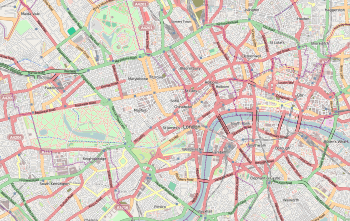Edgware Road tube station (Bakerloo line)
Edgware Road is a London Underground station on the Bakerloo line, located in the City of Westminster. It is between Paddington and Marylebone stations on the line and falls within Travelcard zone 1. The station is located on the north-east corner of the junction of Edgware Road, Harrow Road and Marylebone Road. It is adjacent to the Marylebone flyover.
| Edgware Road | |
|---|---|
_building_(cropped).png) | |
 Edgware Road Location of Edgware Road in Central London | |
| Location | Edgware Road |
| Local authority | City of Westminster |
| Managed by | London Underground |
| Number of platforms | 2 |
| Fare zone | 1 |
| OSI | Edgware Road |
| London Underground annual entry and exit | |
| 2014 | |
| 2015 | |
| 2016 | |
| 2017 | |
| 2018 | |
| Key dates | |
| 15 June 1907 | Opened as terminus (BS&WR) |
| 1 December 1913 | Became through station |
| Other information | |
| External links | |
| WGS84 | 51.520278°N 0.170278°W |
A separate station of the same name but served by the Circle, District and Hammersmith & City lines is nearby, to the south of Marylebone Road.[note 1]
History
Edgware Road station was opened on 15 June 1907 by the Baker Street and Waterloo Railway (BS&WR, now the Bakerloo line) when it extended its line from the temporary northern terminus at Marylebone.[4] In common with other early stations of the lines owned by the Underground Electric Railways Company of London, the station was designed by architect Leslie Green with an ox-blood red glazed terracotta façade. The BS&WR had parliamentary approval to continue the line to Paddington station, but the approved route, which curved under the main line station and ended under the junction of Sussex Gardens and Sussex Place on a south-easterly heading, was not suitable for the company's plan to extend west or north-west from Paddington. The BS&WR chose not to construct the tunnels west of Edgware Road whilst it considered alternatives.[5]
In 1908 the BS&WR considered a joint scheme with the North West London Railway (NWLR) to build a tube line from Edgware Road station to Cricklewood via Kilburn.[6] The NWLR had obtained permission to build a line along Edgware Road from Cricklewood to Marble Arch in 1899,[7] and had received approval for an additional section from Marble Arch to Victoria in 1906, but it had been unable to raise the money to build the line. The permitted NWLR route passed Edgware Road station and the companies sought permission in November 1908 for a section of tunnel 757 metres (2,484 ft) long linking the BS&WR and the NWLR tunnels. To make use of the BS&WR's existing permission for the line to Paddington, Edgware Road station was to be provided with a second pair of platforms to enable the operation of a shuttle service between Paddington and Edgware Road. The scheme was rejected and the line was not built.[6]
In 1911, permission was received to construct a tightly-curved 890-metre (2,920 ft) long extension to Paddington which ended heading north-west under the main line station. Work started in August 1911 and the extension opened on 1 December 1913.[4][8]
When the station opened, its narrow frontage was in a row of shops, but the buildings to the south of the station were demolished in the 1960s to enable the flyover to be built, leaving the station as one of two isolated buildings. Originally, an exit from the station was provided in the adjacent Bell Street. Although this is no longer used the building provides office accommodation for the station managers.
In September 2007, there was a proposal by London Assembly member Murad Qureshi to rename this station Church Street Market, as this would end the confusion between this station and its namesake on the Circle, District and Hammersmith & City lines.[9]
Between 25 May and 21 December 2013, the station closed temporarily for lift maintenance work.[10]
Connections
London Buses routes 6, 16, 18, 98, 332 and 414 and night routes N16, N18 and N98 serve the station.[11][12]
Notes and references
Notes
- The other station was opened by the Metropolitan Railway in 1863 as part of the world's first underground railway.
References
- "Out of Station Interchanges" (XLS). Transport for London. 19 February 2019.
- "Multi-year station entry-and-exit figures (2007-2017)" (XLSX). London Underground station passenger usage data. Transport for London. January 2018. Retrieved 22 July 2018.
- "Station Usage Data" (CSV). Usage Statistics for London Stations, 2018. Transport for London. 21 August 2019. Retrieved 27 April 2020.
- Rose 1999.
- Badsey-Ellis 2005, pp. 267–268.
- Badsey-Ellis 2005, pp. 264–267.
- Badsey-Ellis 2005, pp. 79–83.
- "Paddington Linked Up With The "Bakerloo" Line". The Times (40383): 70. 1 December 1913. Retrieved 9 October 2010.
- "Call to rename twin Tube stations". BBC News. 14 September 2007. Retrieved 14 September 2007.
- "Reminder – New lifts for Edgware Road (Bakerloo line) Station". Transport for London. 21 May 2013. Retrieved 3 August 2014.
- "Buses from Edgware Road" (PDF). Transport for London. Retrieved 9 October 2010.
- "Night buses from Edgware Road" (PDF). Transport for London. Retrieved 9 October 2010.
Bibliography
- Badsey-Ellis, Antony (2005). London's Lost Tube Schemes. Capital Transport. ISBN 1-85414-293-3.CS1 maint: ref=harv (link)
- Rose, Douglas (1999). The London Underground, A Diagrammatic History. Douglas Rose/Capital Transport. ISBN 1-85414-219-4.CS1 maint: ref=harv (link)
External links
| Wikimedia Commons has media related to Edgware Road tube station (Bakerloo Line). |
| Preceding station | Following station | |||
|---|---|---|---|---|
towards Harrow & Wealdstone | Bakerloo line | towards Elephant & Castle |